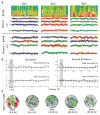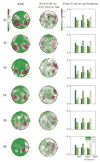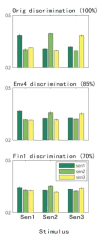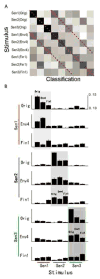Phase patterns of neuronal responses reliably discriminate speech in human auditory cortex
- PMID: 17582338
- PMCID: PMC2703451
- DOI: 10.1016/j.neuron.2007.06.004
Phase patterns of neuronal responses reliably discriminate speech in human auditory cortex
Abstract
How natural speech is represented in the auditory cortex constitutes a major challenge for cognitive neuroscience. Although many single-unit and neuroimaging studies have yielded valuable insights about the processing of speech and matched complex sounds, the mechanisms underlying the analysis of speech dynamics in human auditory cortex remain largely unknown. Here, we show that the phase pattern of theta band (4-8 Hz) responses recorded from human auditory cortex with magnetoencephalography (MEG) reliably tracks and discriminates spoken sentences and that this discrimination ability is correlated with speech intelligibility. The findings suggest that an approximately 200 ms temporal window (period of theta oscillation) segments the incoming speech signal, resetting and sliding to track speech dynamics. This hypothesized mechanism for cortical speech analysis is based on the stimulus-induced modulation of inherent cortical rhythms and provides further evidence implicating the syllable as a computational primitive for the representation of spoken language.
Figures






References
-
- Basar E. Brain function and oscillations. Springer; 1998.
-
- Boemio A, Fromm S, Braun A, Poeppel D. Hierarchical and asymmetric temporal sensitivity in human auditory cortices. Nature Neuroscience. 2005;8:389–395. - PubMed
-
- Dau T, Kollmeier B, Kohlrausch A. Modeling auditory processing of amplitude modulation. II. Spectral and temporal integration. J Acoust Soc Am. 1997;102:2906–2919. - PubMed
-
- Drullman R, Festen JM, Plomp R. Effect of temporal envelope smearing on speech reception. J Acoust Soc Am. 1994;95:1053–1064. - PubMed
Publication types
MeSH terms
Grants and funding
LinkOut - more resources
Full Text Sources
Other Literature Sources

